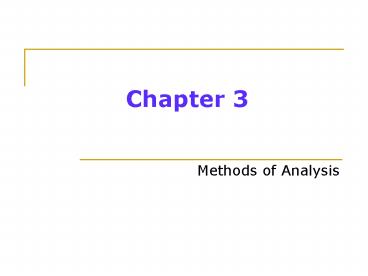Methods of Analysis - PowerPoint PPT Presentation
1 / 22
Title:
Methods of Analysis
Description:
Based on KCL. Mesh Analysis. Based on KVL. 12/1/09. 3 /21. Nodal Analysis ... current source exists only in one mesh. Set the mesh current ... Inspection ... – PowerPoint PPT presentation
Number of Views:71
Avg rating:3.0/5.0
Title: Methods of Analysis
1
Chapter 3
- Methods of Analysis
2
Introduction
- Techniques for circuit analysis
- Nodal Analysis
- ? Based on KCL
- Mesh Analysis
- ? Based on KVL
3
Nodal Analysis without Voltage Source
- Make use of node voltages as circuit variables.
- Given a circuit with n nodes
- Select a node as the reference node.
- Reference node ? Node with 0 potential.
- Assign voltages v1, v2, vn-1 to the remaining
n-1 nodes. The voltages are referenced with
respect to the reference node. - Apply KCL to each of the n-1 non-reference nodes.
Use Ohms Law to express the branch currents in
terms of node voltages. - Solve to determine the unknown node voltages. Use
substitution method or Cramers Rule.
4
Nodal Analysis without Voltage Source
- Example 1
- Obtain the node voltages.
- Answer
- v1 -2v
- v2 -14v
5
Nodal Analysis without Voltage Source
- Example 2
- Find the voltages at the three non-reference
nodes. - Answer
- v1 80v
- v2 -64v
- v3 156v
6
Nodal Analysis with Voltage Source
- Two cases to consider
- Case 1 A voltage source is connected between
reference node and non-reference node. - Set the voltage at the non-reference node equal
to the voltage source. - Case 2 A voltage source connected between two
non-reference node - The two non-reference nodes form a super node.
- Apply both KCL and KVL to determine the node
voltages. - Super node is formed by enclosing a (dependent
or independent) voltage source connected between
two non-reference nodes and any elements
connected in parallel with it.
7
Nodal Analysis with Voltage Source
- Properties of super node
- The voltage source inside the super node provides
constraint equation needed to solve for the node
voltages. - A super node has no voltage of its own.
- A super node requires the application of both KCL
and KVL.
8
Nodal Analysis with Voltage Source
- Example 1 Find v and i
- v-0.2v, i 1.4A
9
Nodal Analysis with Voltage Source
- Example 2 Find v1, v2 and v3 using nodal
analysis - v1 -3.043 V, v2 -6.956 V, v3 0.6522 V
10
Mesh Analysis
- Make use of mesh currents as circuit variables
- A mesh is a loop that does not contain any other
loop within it. - Only applicable to a planar circuit
- Planar circuit
- A circuit that can be drawn in a plane with no
branches crossing one another otherwise
non-planar.
11
Mesh Analysis
- Planar circuit
- ?
12
Mesh Analysis
- Non-planar circuit
- No way to redraw it and avoid the branches
crossing
13
Mesh Analysis without Current Sources
- Given a circuit with n meshes.
- Assign mesh currents i1, i2, .. in to the n
meshes. Assume mesh current flows clockwise. - Apply KVL to each of the n meshes. Use Ohms Law
to express the voltages in terms of mesh currents.
14
Mesh Analysis without Current Sources
- Example 1 Determine mesh currents i1 and i2.
- i1 2/3 A
- i2 0A
15
Mesh Analysis without Current Sources
- Example 2 Determine I0 .
- I0 -5A
16
Mesh Analysis with Current Sources
- Two cases to consider
- Case 1 A current source exists only in one mesh.
- Set the mesh current current source.
- Case 2 A current source exists between the two
meshes. - Create super mesh by excluding the current source
and any elements connected in series with it. - A super mesh results when two meshes have a
(dependent or independent) current source in
common.
17
Mesh Analysis with Current Sources
- Properties of super mesh
- Current source in the super mesh provides the
constraint. - Super mesh has no current of its own.
- Super mesh requires the application of both KVL
and KCL.
18
Mesh Analysis with Current Sources
- Example 1 Determine i1, i2 and i3.
- i13.474
- i2 0.4737
- i3 1.1052
19
Nodal Analysis by Inspection
- Implemented when all sources in the circuit are
independent current sources. - Convert resistors to conductors.
20
Nodal Analysis by Inspection
- Example By inspection, determine the
node-voltage equations for the circuit.
21
Mesh Analysis by Inspection
- Implemented when all sources in the circuit are
independent voltage sources.
22
Mesh Analysis by Inspection
- Example By inspection, determine the
mesh-current equations for the circuit.































